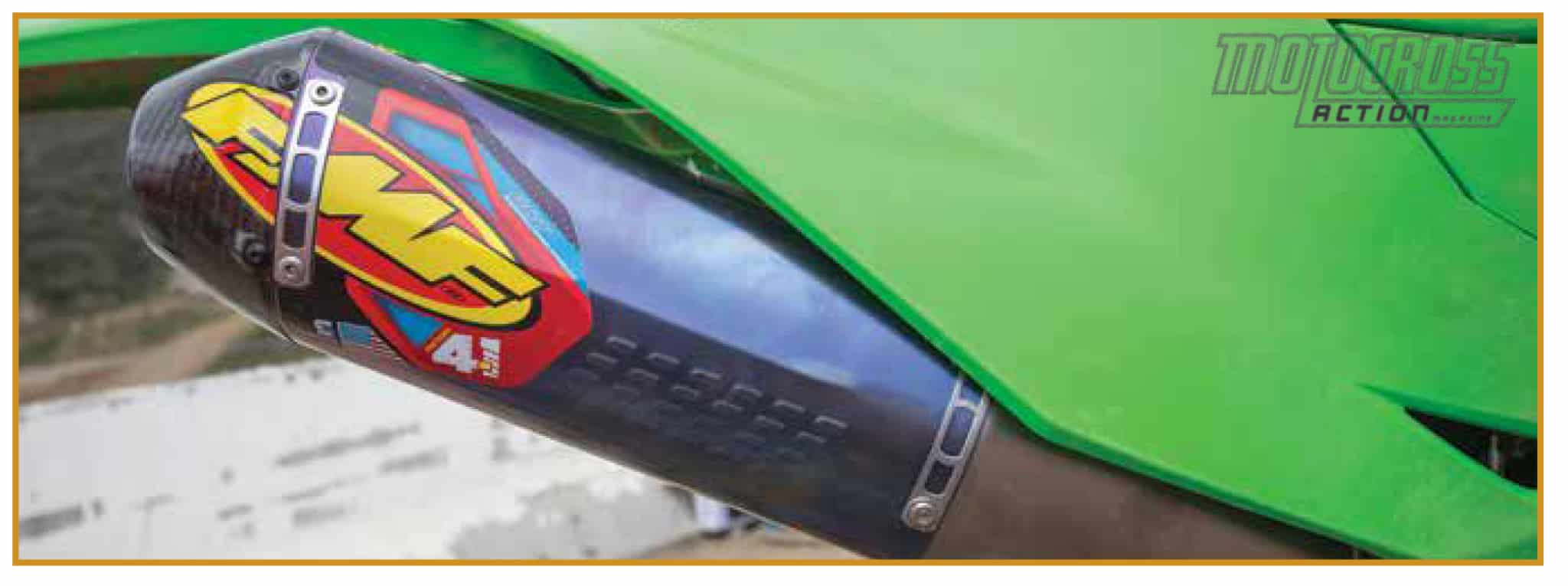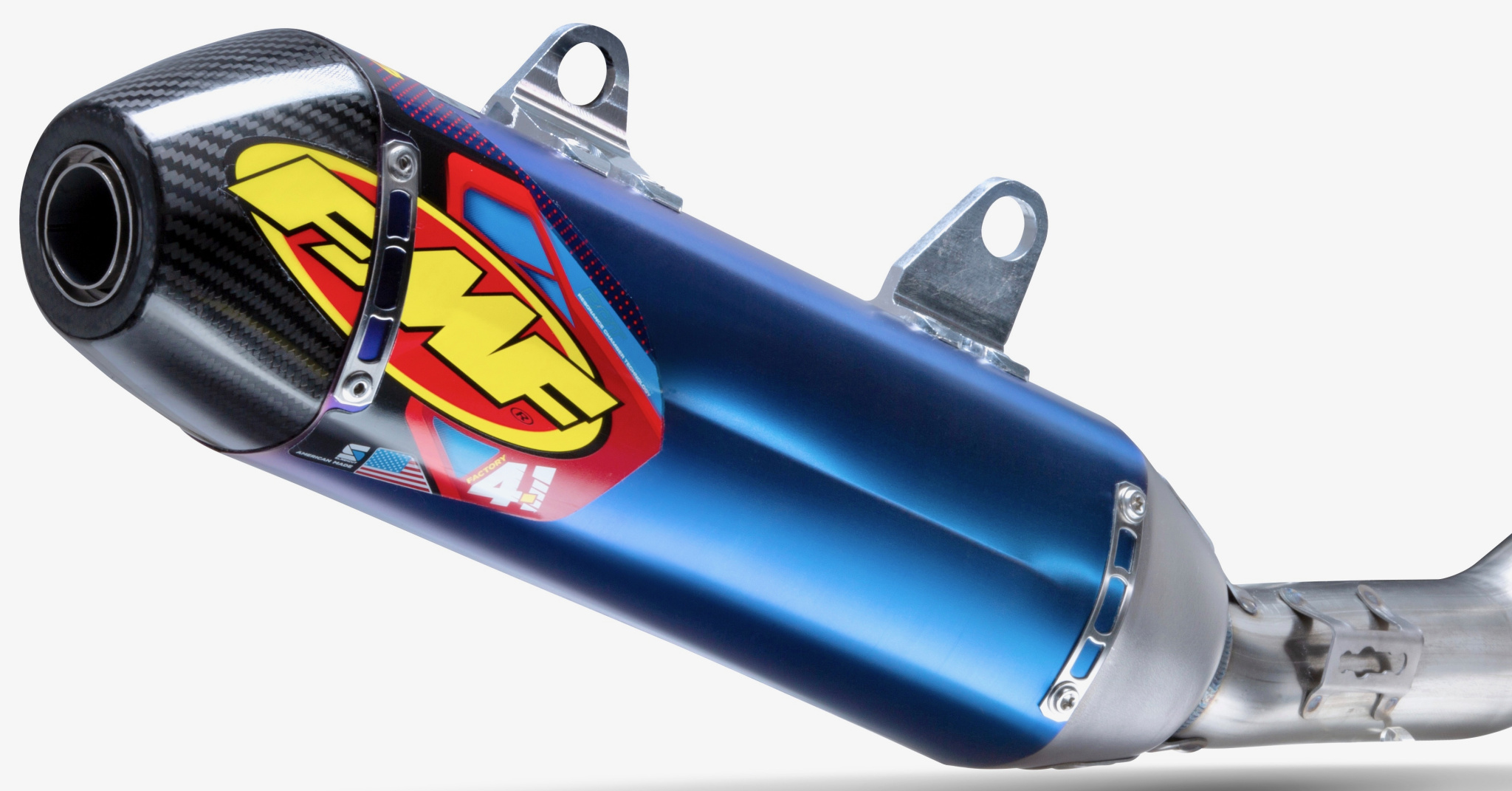MXA TEAM TESTED: FMF RACING 2024 KX450 SLIP-ON MUFFLER

WHAT IS IT? The all-new KX450 engine is good, but it’s hindered by two things: (1) The intake system and (2) the stock exhaust system. The FMF slip-on muffler is $475 cheaper than the full system, and it solves some serious problems.
WHAT’S IT COST? $674.99 (stainless), $899.99 (titanium).
CONTACT? www.fmfracing.com or (310) 631-4363.
WHAT STANDS OUT? Here’s a list of things that stand out with the FMF 4.1 RCT slip-on muffler for the 2024 Kawasaki KX450.
(1) KX450 psychology. The KX450 marketing department should have told us that they suffocated their bike to make sure they would meet the new sound regulations coming in the next few years. That way, we would have known from the beginning that this bike needed help. Of course, we figured out the 2024 KX450’s power deficit very quickly.
The stock 2024 KX450 feels almost like a KTM 350SXF on the track. That’s not necessarily a bad thing. Most Vets, Novices and even Intermediates would be better off with a slower bike anyway; however, most riders don’t buy a 450 because they want an “easy-to-ride machine.” It might be a flawed way of thinking, but most Vets think they would be faster if they had a faster bike when the reality is they would benefit much more from a weekly session with a riding coach.

In stock form, the KX450 doesn’t have much get-up-and-go. The bottom end feels sluggish, but the bike continues to pull up to speed. It likes to be revved out in second gear before upshifting to third. On top, the KX450 isn’t all that impressive.
(2) FMF slip-on. Because this is an all-new bike, FMF made sure to produce a slip-on muffler first, just to get some extra power out to the public before finalizing their complete system (with the header and muffler combined). We like testing slip-on mufflers because they are more affordable and tick the boxes for most riders.
The FMF slip-on muffler comes with an insert to tune the power for your riding style and track conditions. You can ride with the insert in, or you can modify the insert by removing the wire screen from the back, or you can take the whole insert out completely.
(3) Performance. On the dyno, the stock KX450 engine climbs steadily to 6700 rpm and then peters out. The FMF system continues with a strong power curve, peaking at 9200 rpm, while the stock system takes its time getting up to the same peak rpm number. The FMF system is 3 horsepower stronger than the stock muffler at 7500 rpm. The stock system does eventually catch the FMF slip-on and match the peak number at 57.3 horsepower. The FMF muffler did improve torque from 35.6 to 36.8 pound-feet against the stock muffler.
(4) Track testing. Going from the stock system to the FMF slip-on (with the insert in) woke up the bike on the top end. Our test riders could get going faster up the hills and down long straights; however, low-end throttle response wasn’t improved. The bottom end still felt sluggish until the powerband got into the midrange. Once we removed the muffler insert, it felt even more powerful on top. The bike revved through the gears quicker and wanted to get into third sooner.
The bottom end never saw a significant improvement with the slip-on muffler. At this point, we switched to the 51-tooth rear sprocket, installed the Twin Air PowerFlow kit, and drilled holes in the airbox cover. The sprocket change helped the most, but the improved airflow was also a benefit. In the end, the KX450 became much more lively and exciting to ride with the bigger rear sprocket, and improved airflow helping throttle response and bottom-end grunt.
WHAT’S THE SQUAWK? We wish the FMF slip-on muffler had given the KX450 more bottom, but we assume the header will help with that.
MXA RATING: The stainless steel FMF slip-on muffler is slightly heavier than the titanium version, but it produces the same power and offers great bang for the buck. The FMF setup picks up all the horsepower that Kawasaki left on the table, connecting the dots from mid to top.







Comments are closed.